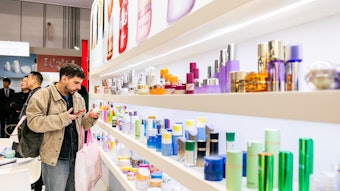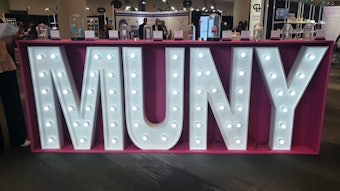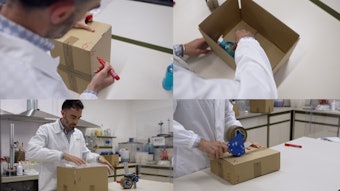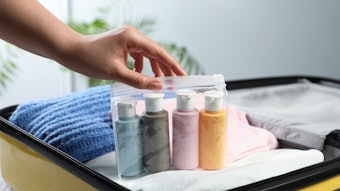
The future of beauty packaging lies in its ability to adapt to the evolving demands of consumers and the environment. This means embracing sustainability through the use of recyclable materials, refillable containers, and eco-friendly packaging designs. Additionally, innovation will play a key role in creating smart packaging that enhances the user experience and incorporates technology to provide personalized solutions and product information. Convenience will also remain a priority, with a focus on travel-friendly, easy-to-use, and on-the-go packaging formats.
Sustainability Meets Savings
Adam McGinley, purchasing manager at McKernan Packaging Clearing House explains, “Since 1967, the surplus purchasing program has allowed packaging that might otherwise end up in a landfill to be repurposed and be made available for immediate use by another company. Recycling is another option, but our precycling program helps avoid the extra energy necessary to the recycling process while allowing these products to go back into the industry right away.” Maria Alexeeva, sales manager at McKernan Packaging Clearing House said, “Packaging that is excess to one enterprise can be extremely valuable to another."AdobeStock by romaset
Maria Alexeeva, sales manager at McKernan Packaging Clearing House said, “Packaging that is excess to one enterprise can be extremely valuable to another."AdobeStock by romaset
Maria Alexeeva, sales manager at McKernan Packaging Clearing House, says, “Packaging that is excess to one enterprise can be extremely valuable to another. Given the significant impact of packaging on consumer purchasing decisions, companies can benefit from our surplus inventory. These high-quality items come from multinational marketers, while being economically and ecologically conscious.”
McGinley agrees, “The surplus inventory paired with McKernan’s unique small order program creates more opportunity for businesses of any size. Utilizing the repurchase program gives companies an opportunity to have fewer financial obligations by providing an option to purchase a lower minimum order quantity. These orders will be at a significantly lower cost than if customers went directly to the manufacturer, while the product quality remains the same.”
“Our Surplus programs are perfect for companies that cannot wait due to long lead times and large minimums, or simply can’t or won’t pay a manufacturer’s full price,” adds Alexeeva. “Buying surplus not only saves money on packaging, but also provides a budget-friendly opportunity to source components sustainably.”
“Brands considering a new product line or a complete packaging change and don’t want to limit their options have the opportunity to use the unused and unbranded surplus stock,” McGinley says. “These items provide lower financial expenses and risks while still delivering a high-quality product.”
“Large corporations have already invested millions of dollars in research to determine what works best," Alexeeva explains. "Our Surplus Program represents an excellent opportunity to buy brand-new, unused quality packaging components at discounted rates. McKernan has established a widespread network of packaging suppliers, which sources a variety of components-- all available in our Best Value line.”
Increased Recyclability of Materials
Enhancements in packaging materials and design enable greater recyclability, contributing to a circular economy and reducing environmental impact. This includes the development of innovative materials that are easier to recycle, as well as design strategies that simplify the recycling process. Additionally, advances in recycling technologies and infrastructure are expanding the range of materials that can be effectively recycled.
APC Packaging Introduces Mono-Material Color Cosmetics Collection
 Each product in Mono-Material Color Cosmetics Collection can be designed with up to 50% PCR (PP 5g Stick is capable of 100% PCR), enabling beauty brands to reduce their environmental impact without compromising on quality or aesthetics.APC Packaging
Each product in Mono-Material Color Cosmetics Collection can be designed with up to 50% PCR (PP 5g Stick is capable of 100% PCR), enabling beauty brands to reduce their environmental impact without compromising on quality or aesthetics.APC Packaging
The collection includes the following pieces:
- 100% PET 3.5g Lip Stick
- 100% PET 5.2ml Lip Balm
- 100% PP 5g Stick (bottom fill)
- 100% PP 1.3g Twist Pen
- 100% PP 1.8g Lip Stick
- 100% PP 0.06g Twist Pen
Each product in this collection can be designed with up to 50% PCR (PP 5g Stick is capable of 100% PCR), enabling beauty brands to reduce their environmental impact without compromising quality or aesthetics. The use of mono-materials such as PET and PP ensures that the packaging aligns with global sustainability goals.
Arcade Beauty to Eliminate Non-recyclable Designs by 2030
By the end of 2025, Aptar Beauty will reportedly ensure that 100% of its products have a recyclable alternative, will be water-soluble or compostable.
In addition, at least 75% will integrate recycled or certified material.
“As a global industrial company, we are committed to providing sustainable solutions through our deep manufacturing and packaging expertise to support the needs of the beauty industry," CEO Carl Allain notes.
He adds, "By 2030, just as we will no longer manufacture non-recyclable products, it will no longer be acceptable to throw away unused beauty products, whether in a sample or full-size format."
Allain concludes, “We are redirecting our business to become a contributive company and as one of the four pillars of our CSR policy, eco-design is at the core of our sustainable activities."
Smart, Sustainable Packaging
Max Farrow, marketing manager, Nuon Medical Technologies, says, “In 2025, Nuon is proud to introduce its Smart Applicator Series, a range of packaging solutions designed to elevate user experiences. These applicators feature, for example, integrated NFC technology, enabling personalized skincare regimens and seamless consumer engagement. Our devices combine functionalities such as phototherapy, microcurrents, and pulsed electromagnetic fields (PEMF), delivering unparalleled efficacy and experience.”
Sustainability at the Forefront
 Max Farrow, marketing manager, Nuon Medical Technologies says, “Sustainability is a cornerstone of our innovation. Our latest packaging designs incorporate biodegradable materials, post-consumer recycled plastics, and modular refillable systems."Global Cosmetics Industry
Max Farrow, marketing manager, Nuon Medical Technologies says, “Sustainability is a cornerstone of our innovation. Our latest packaging designs incorporate biodegradable materials, post-consumer recycled plastics, and modular refillable systems."Global Cosmetics Industry
He concludes, “In 2025, we anticipate a surge in demand for device-topical hybrids, eco-conscious materials, and interactive packaging designs that enhance transparency and consumer engagement.”
The Glassification of Packaging
"Glassification" refers to the increasing use of glass in beauty and cosmetic packaging. The reasons for this shift are largely driven by consumer and regulatory demands for sustainable alternatives to plastics. According to a 2025 report from Market Research Gurua, the global cosmetic and perfume glass packaging market size was valued at $3965.38 million in 2022. It is expected to expand at a CAGR of 5.51% during the forecast period, reaching $5471.95 million by 2028., with beauty and personal care among the driving forces.
Glass offers a host of benefits:
- Sustainability: Glass is fully recyclable without losing quality. Unlike plastics, it contributes to a circular economy.
- Preservation: Being inert and non-reactive, glass preserves product quality by shielding formulas from oxidation and contamination.
- Premium Appeal: Glass’ weight, clarity, and gloss lend a luxurious feel, appealing to consumers who value aesthetics as much as functionality.
Luxury Looks for Glass
The beauty industry is synonymous with glamour, and glass packaging serves as the perfect canvas for creating luxury aesthetics. Premium skin care and fragrance brands have embraced techniques like frosted glass, metallic accents, and intricate embossing to elevate the look and feel of their products.
Balancing Luxury and Sustainability
One of the industry’s biggest challenges is balancing opulence with eco-consciousness. Consumers expect beauty brands to contribute to the sustainability movement while maintaining the high-end feel they’re accustomed to. Enter lightweight glass.
Lightweight glass reduces both the material’s carbon footprint during production and shipping emissions, thanks to its reduced weight. Despite being lighter, it retains the visual luxury and durability that glass offers. Furthermore, refillable glass products are gaining traction in the industry, especially for skin care and perfume packaging.
An example of this is Guerlain's iconic “Bee Bottle,” introduced with a refillable offering, allowing customers to keep their ornate glass bottles while reducing waste and SGD Pharma’s PCR Glass Bottles, featuring 20% post-consumer recycled (PCR) glass.
Focus on Sustainability and Innovation
 Wheaton Packaging showcased the Ecoglass Line, refillable bottle designs, decoration techniques, including Crystal Effect Painting and Marble Effect Painting at Paris Packaging Week 2025.Wheaton Packaging
Wheaton Packaging showcased the Ecoglass Line, refillable bottle designs, decoration techniques, including Crystal Effect Painting and Marble Effect Painting at Paris Packaging Week 2025.Wheaton Packaging
Bottles
Wheaton also recently added a new 200 ml bottle, designed from a proposal for refill, promoting the circular economy. According to the company, the bottle is lightweight, with about 20% less glassy mass than traditional bottles, resulting in a significant reduction in energy consumption, as well as a reduction of about 15% in CO2 emissions.
The screw termination allows the refilling of the perfume, encouraging the conscious use of the packaging, in addition to facilitating the recycling process, uniting innovation and environmental responsibility.
Decoration
As for the innovations in decoration, Wheaton created Hot Stamping tapes. The technique consists of a decoration process through a thermal tape, which produces recordings in various colors, with many options of differentiated effects.
Another technique created by Wheaton is Crystal Effect Painting, obtained by applying a special varnish that creates a particular effect around the painting, giving each bottle a unique aesthetic. This process values the sophistication of glass packaging, providing not only a visually captivating appearance, but also a tactile feel. Decorative glass designs are transforming the fragrance and beauty market, blending artistry with sophistication to enhance consumer appeal.AdobeStock by micro
Decorative glass designs are transforming the fragrance and beauty market, blending artistry with sophistication to enhance consumer appeal.AdobeStock by micro
Among Wheaton's innovative decoration techniques, Marble Effect Painting stands out for its ability to imbue bottles with a sense of elegance, sophistication, and timeless beauty. Inspired by the look and texture of natural stone, this technique creates a modern, refined aesthetic that bridges technology and nature. Each bottle becomes a unique piece, offering a distinctive depth and character that resonates with consumers on a deeper level.
New Packaging Concepts for Added Convenience
Dana Peterson, director of marketing and communications, ICONS|ICS, says, “Chubby pansticks are one of the hottest trends in the stick category for lip and cheek formulations as well as multi-functional skin care formulations for the face and body. And at ICONS|ICS, we have several new chubby panstick options, including new mono material PP chubby sticks, which are ideal for color cosmetic, skincare, body care and even hairstyling stick formulations. They are a travel-friendly, versatile option that can be used anytime, anywhere – just swipe on and go.”
 Dana Peterson, director of marketing and communications, ICONS|ICS says, “Chubby pansticks are one of the hottest trends in the stick category for lip and cheek formulations as well as multi-functional skincare formulations for the face and body."ICONS Beauty Group
Dana Peterson, director of marketing and communications, ICONS|ICS says, “Chubby pansticks are one of the hottest trends in the stick category for lip and cheek formulations as well as multi-functional skincare formulations for the face and body."ICONS Beauty Group
Peterson concludes, “Sticks suit a wide range of formulations and we have a variety of options in various shapes and sizes including recyclable mono-material PP or PET sticks with option to add PCR, refillable options, top fill or back fill, and airtight options.”
The Benefits of Sustainable Packaging Materials
 The plastics industry is the fastest-growing source of industrial greenhouse gases in the world and is estimated to account for 19% of the global carbon budget by 2040.Sulapac
The plastics industry is the fastest-growing source of industrial greenhouse gases in the world and is estimated to account for 19% of the global carbon budget by 2040.Sulapac
“Our materials enable companies to reduce the use of fossil fuels and lower their carbon footprint,” says Heidi Peltola, chief product officer at Sulapac. “But there is more: Sulapac materials leave no permanent microplastics or toxic residues behind. By opting for Sulapac, companies can contribute to healthier ecosystems and improve human well-being.”
Peltola also emphasizes the recyclability of Sulapac materials, stating, “They can be effectively—and almost indefinitely—recycled in a ‘polymer-to-polymer’ process. This lays the foundation for a truly sustainable, circular packaging industry. By joining Sulapac on this journey, beauty companies are building a better future for us all.”
She adds, “The plastics industry is the fastest-growing source of industrial greenhouse gases in the world and is estimated to account for 19% of the global carbon budget by 2040. Improved recycling of conventional plastic is not enough to stop this detrimental development; more radical changes are needed."
For the beauty and personal care industry, Peltola outlines a clear path forward: “This means favoring refill concepts and choosing renewable materials that are also truly recyclable, not downcyclable. Using materials that do not add to the global problem of microplastic pollution is fundamental to securing a livable planet for our children. It also helps prevent the rise of severe diseases linked to the accumulation of microplastics in human organs.”
Peltola adds, “A common challenge across our sector is that data on biobased and biodegradable materials in many Life Cycle Assessment (LCA) databases is outdated, and some evaluation methods show bias. For example, the environmental effects of oil drilling are largely ignored, while landfills are considered a sustainable end-of-life solution for conventional plastic, even though research shows that leaching chemicals threaten the quality of groundwater and microplastic release impacts wildlife and human health."
Peltola concludes, "Although most beauty companies have set ambitious goals and targets for their sustainability performance, the pace of change sometimes feels painstakingly slow. Instead of going out one pilot project at a time, companies could be more agile in the large-scale adoption of new sustainable concepts and materials. Due to the pressing environmental problems like climate change and the emerging threat of microplastic pollution, we must be bold in our actions–and act now.”
Reducing Costs
Moira Stein, insights and strategy consultant, Berlin Packaging, says, “There are a few things we recommend to help our customers reduce their packaging costs. Companies can streamline their inventory by sharing components across brands or products. For example, a hair care brand can use the same component for both shampoo and conditioner and only change the decoration. This can result in a price reduction by ordering a higher volume of the component.”
 Althea Skin's line of science-backed skin care products using Berlin Packaging’s exclusive Airglass refill packaging system.Berlin Packaging
Althea Skin's line of science-backed skin care products using Berlin Packaging’s exclusive Airglass refill packaging system.Berlin Packaging
Stein concludes, “Althea Skin recently launched its line of science-backed skin care products using Berlin Packaging’s exclusive Airglass refill packaging system. The recyclable glass containers are refillable and pair with recyclable plastic refill cartridges to support the circular economy and reduce packaging waste. The brand claims to use cartons that are FSC-certified and made in a women-owned, Zero Waste factory using solar energy.”
Footnotes:












